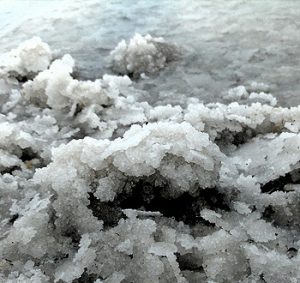Have you ever stopped to think about the types of salt you use in your daily diet? Japan is home to more than 4,000 unique varieties of salt, and each type has its own unique properties, flavor, and health benefits. But with so many types of salt, how do you know which one is best for you and your diet? Learning more about the differences between salt varieties can help you make informed decisions about which one to use when cooking, seasoning, and preserving food. So how many types of salt do you know? Explore the world of salt and find out why it’s worth paying attention to the type you use.
Salt is much more than just an essential seasoning in our diets. Its long and storied history dates back thousands of years, when the Egyptians were first believed to have used it to preserve their food. Since then, salt has been used in cuisines all around the world to enhance flavors and bring our favorite dishes to life. In fact, it’s often said that a sprinkle of salt can make even the sweetest baked goods taste even sweeter.
So why not try it today? A pinch of salt on a slice of juicy watermelon will truly transform your taste buds.
How Much Salt Is Too Much?
Salt is more than just a seasoning – it’s also an essential nutrient for your body. Its chemical name is sodium chloride, and it’s composed of two minerals – sodium and chloride – that are both important to our health. Sodium is necessary for contractions in all of our muscles, including our heart, and we need about 500 milligrams of sodium each day for our bodies to function properly.
Salt adds a lot of flavor to food, but too much sodium can lead to water retention and high blood pressure, which is a major risk factor for heart health. To keep your blood pressure in check, it’s important to watch your sodium levels and make sure you’re getting enough potassium to balance out the effects of salt. Unfortunately, many Americans are falling short on their potassium intake, so it’s especially important to monitor your sodium intake to keep your blood pressure in a healthy range.
The average American consumes an alarming 3,400 mg of salt per day — way beyond the recommended amounts for good health. The 2020–2025 Dietary Guidelines for Americans advises limiting your daily sodium intake to 2,300 mg or less — about the amount in one teaspoon of table salt.
The American Heart Association takes it a step further, recommending a threshold of 1,500 mg of sodium per day, especially for those with high blood pressure or heart disease. They do point out, however, that cutting back even a little each day can make a big difference for heart health in the long run. By making small changes to your eating habits, you can easily reduce your daily salt intake and improve your heart health.
The American Heart Association reports that more than 70 percent of the sodium in our diets comes from processed foods—not from a salt shaker. While most people know that deli meats, canned soups, and other processed foods are notorious for high sodium content, many everyday foods like bread, salad dressings, and cheese also contain large amounts of salt.
To lower your blood pressure, the most important step you can take is to reduce your intake of processed, packaged, and restaurant foods and include more unprocessed, whole foods in your diet. Eating a balanced diet filled with fresh fruits and vegetables, lean proteins, and whole grains is the best way to ensure you are getting the proper nutrients—and the right amount of sodium—your body needs.
When it comes to seasoning your food, the type of salt you choose can make all the difference in flavor. According to research, the size of the salt crystals and the minerals they contain are what give salt its flavor and salty taste. So when it comes to adding salt to your meals, choosing the right type can have a big impact on the overall flavor.
Types of Salt
Learn about the different types of salt and their uses. From table salt to sea salt, each one has its own unique flavor and purpose. Knowing the differences can help you pick the right one for your recipes.
1. Iodized Salt or Table Salt
Iodized salt is the most common type of salt and the one that you’ll find in most salt shakers. It’s processed to remove trace minerals and fortified with iodine, which is an essential nutrient for humans and helps maintain thyroid health. The U.S. government began iodizing salt in 1924 to help reduce iodine deficiency, but many people now get enough iodine from other food sources, such as bread, seafood, and milk.
Therefore, while iodized salt is still essential in impoverished countries, it may not be necessary in the US. Additionally, iodized salt has a small crystal size that makes it more intensely flavored than salts with larger crystals, such as kosher salt. If you’re looking for a more subtle flavor, try experimenting with other types of salt.
2. Hawaiian Salt
Like many things from Hawaii, their salt is both beautiful and flavorful! You can find it in two varieties – red alaea salt and black ‘lava’ salt. Red alaea salt gets its distinctive color from a type of clay found in Hawaii, while black ‘lava’ salt gets its color from naturally occurring activated charcoal. Both are packed with trace minerals that add a unique flavor to your dishes, but don’t expect any sodium savings over regular table salt. These salts can be used during cooking, but their light crunch and stunning colors make them the perfect finishing salt too. Enjoy the unique flavors and beauty of Hawaiian salt!
3. Sea Salt
Sea salt is the perfect choice for those looking to enjoy a more natural flavor and the benefits of trace minerals! Unlike table salt, which is heavily processed to remove minerals, sea salt is simply evaporated from seawater, leaving its natural minerals intact. While both sea salt and table salt contain similar levels of sodium, sea salt has a more complex flavor that many find more enjoyable. So why not give it a try today?
4. Pink Himalayan Salt
Mined from ancient seabeds in Pakistan, this pink Himalayan salt is a naturally occurring variety of salt that contains trace minerals. While people often claim that the minerals found in this salt can make it healthier, there is no substantial scientific evidence to back up this assertion. In terms of its main nutrient, sodium, Himalayan salt is comparable to regular table salt, containing approximately the same amount by weight.
Despite lacking scientific support, some people believe that lamps crafted from large blocks of pink Himalayan salt can improve air quality and help you sleep better by releasing negative ions. Unfortunately, there is no real evidence to back up these claims.
5. Kosher salt
Diamond Crystal kosher salt is the ideal choice for everyday cooking due to its unique size and flavor. Compared to iodized salt and other brands of kosher salt, Diamond Crystal contains up to 48% less sodium per teaspoon! USDA data shows that 1 teaspoon of iodized salt contains 2,330 mg of sodium, whereas Morton kosher salt contains 1,920 mg and Diamond Crystal contains just 1,120 mg. Not only will you save on sodium, but you’ll also get a cleaner, less salty flavor due to the lack of iodine and trace minerals and the larger grain size of kosher salt. Don’t pass up this opportunity to make your everyday cooking healthier and more flavorful!
6. Flaked sea salt
Flaked sea salt is the perfect choice to add a salty crunch and sparkle to your dishes. Harvested from the sea, the salt is evaporated to form large, crunchy flakes. For a truly magical experience, try sprinkling a few flakes on top of your homemade chocolate chip cookies – the perfect finishing touch!
Conclusion
If you’re not at risk of iodine deficiency, ditch the iodized salt and experience improved, enhanced flavor. Choose the right type of salt for each dish – many recipes will specify – and add just enough to bring out the flavor, but never overdo it. To help you reduce sodium, avoid processed foods as much as possible.
Hope you found this article useful and informative. If you really loved it then please share it on social media with your friends and family to spread awareness.


















